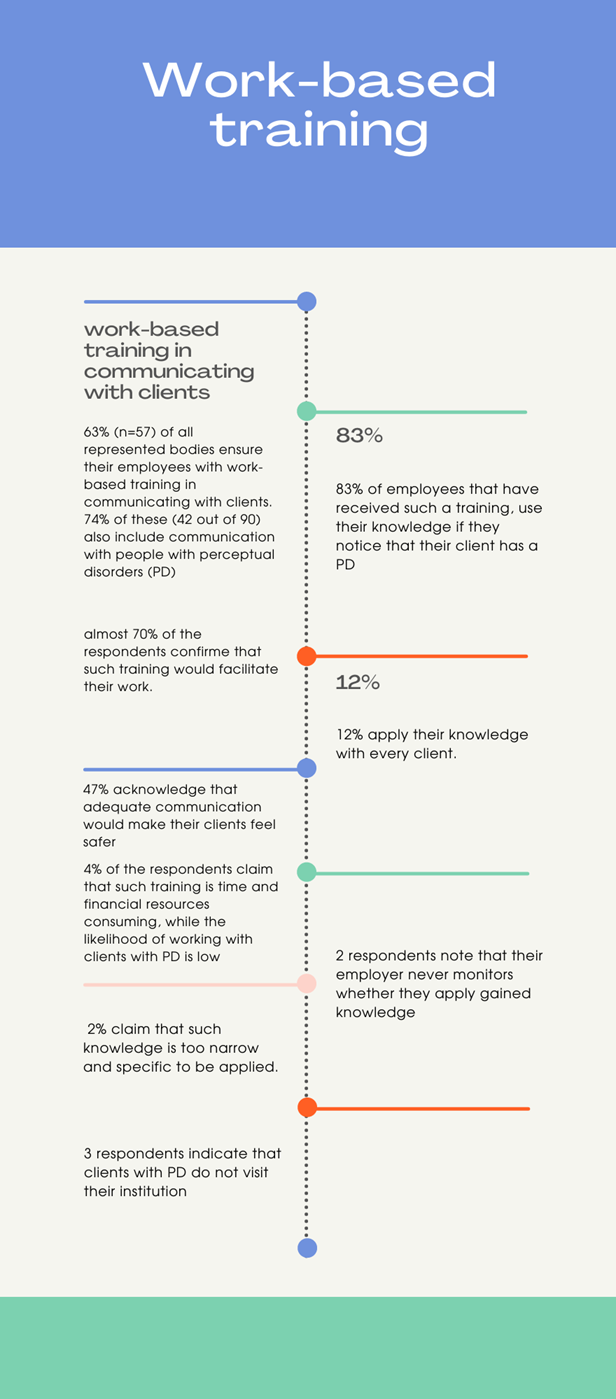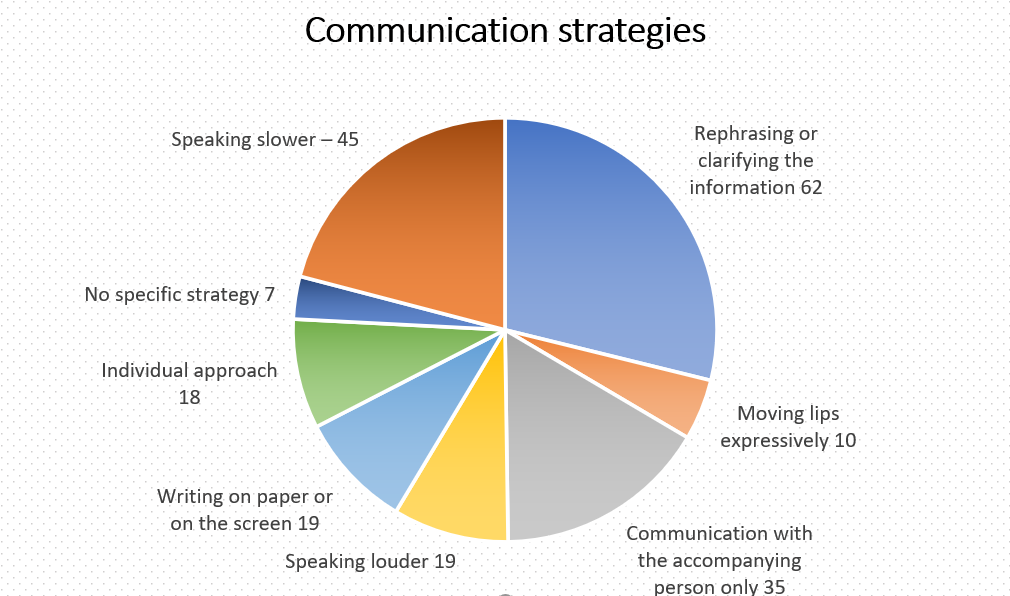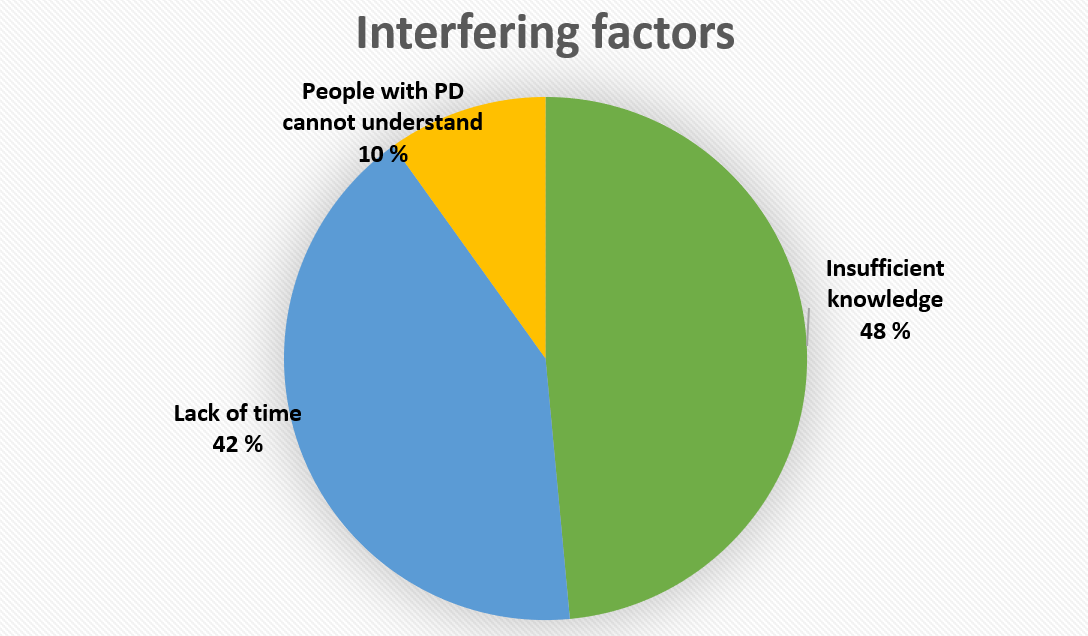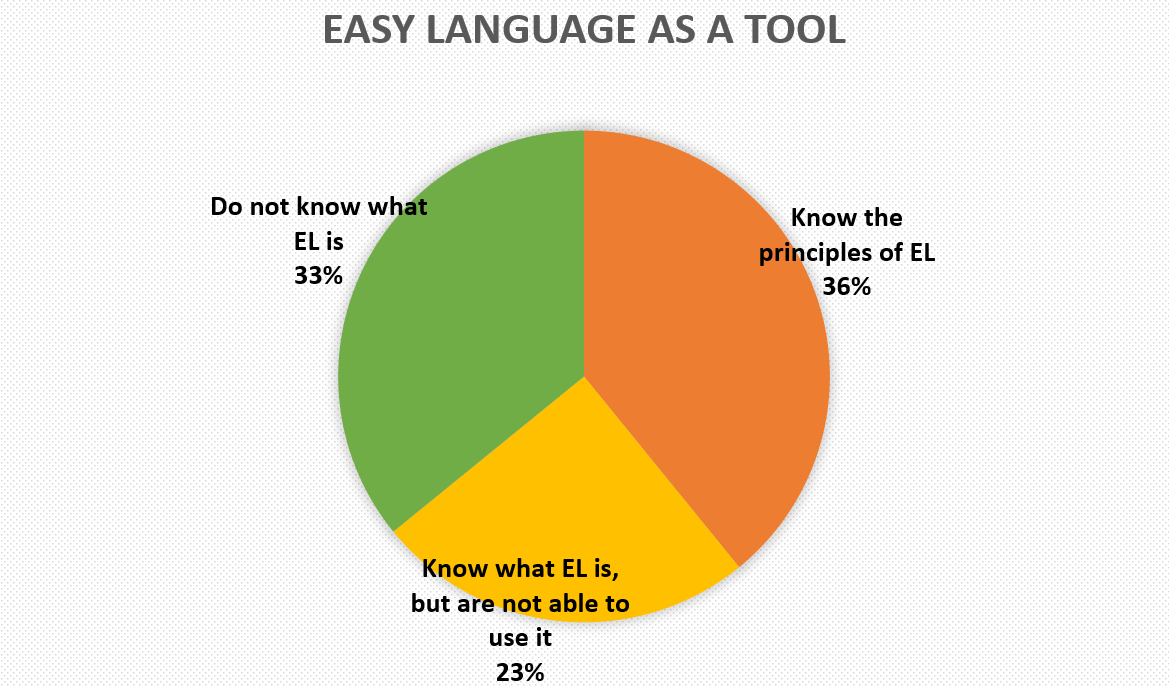Erilaiset lomakkeet ovat tuttuja terveydenhoidossa. Lomakkeita käytetään apuna esimerkiksi mielenterveyden ongelmien tunnistamisessa ja diagnosoinnissa. Jos vastaanotolla on asiakkaan ja ammattilaisen lisäksi tulkki, lomakkeen on oltava paitsi ymmärrettävä myös sujuvasti käännettävissä suomesta muille kielille.
Suomalaiset tutkijat kiinnittävät PALOMA-käsikirjassaan huomiota siihen, että yleisesti käytössä olevat tutkimusmenetelmät eivät välttämättä toimi pakolaistaustaisten henkilöiden psykologisissa arvioinneissa. Menetelmien käytössä tulee esiin monenlaisia kulttuuriin ja kieleen liittyviä haasteita. Maahanmuuttajataustaisten henkilöiden mielenterveyden ongelmia olisi kuitenkin tärkeää tunnistaa. Terveydenhoidon ammattilaisia kannustetaan tekemään tutkimuksia ja arviointia soveltuvin, luovin ja joustavin menetelmin. (Castaneda & al. 2018)
Mitä nämä soveltuvat, joustavat ja luovat menetelmät voisivat olla? Voisivatko kielentutkijat auttaa menetelmien ja erityisesti lomakkeiden kehittämisessä?
Tuoreessa juuri vertaisarviossa olevassa pilottitutkimuksessa selvitimme, miten masennuksen seulonnassa käytettävän PRIME-MD-lomakkeen kieltä voisi yksinkertaistaa. Vain kaksi kysymystä sisältävä lomake näkyy kuvassa 1.
 Kuva 1. PRIME-MD:n kahden kysymyksen seula yleiskielinenä (Käypähoito).
Kuva 1. PRIME-MD:n kahden kysymyksen seula yleiskielinenä (Käypähoito).
Jos asiakas vastaa vähintään toiseen kysymykseen myöntävästi, kyseessä voi olla masennus, ja asian selvittäminen vaatii tarkempia tutkimuksia. Kuten Käypähoito-sivulla huomautetaan, lomake ei korvaa kliinistä haastattelua, vaan lomaketta käytetään yhtenä työkaluna masennuksen tunnistamisessa. Lomakkeen kielellisillä muotoiluilla ja ymmärrettävyydellä on kuitenkin merkitystä: jatkotoimet riippuvat siitä, vastaako asiakas kysymyksiin myöntävästi vai kieltävästi.
Selkokieltä tarvitsevan näkökulmasta lomakkeen kysymykset ovat hankalia. Virkkeet ovat pitkiä, niiden rakenne on mutkikas, eikä sanastokaan ole kaikilta osin yleistä ja tuttua.
Tutkimuksemme ensimmäisessä vaiheessa lomakkeen kieltä yksinkertaistettiin ensin perusselkokielelle ja sitten helpolle selkokielelle. Perusselkokielinen versio teetettiin Selkokeskuksessa, ja se noudattaa perusselkokielelle annettuja ohjeita. Helpon selkokielen versio pohjautuu alkusanakieleen, sen tekivät tutkijat, ja sille haettiin Selkokeskuksesta helpon selkokielen hyväksyntä. Näin saadut kolme eritasoista versiota näkyvät kuvassa 2.
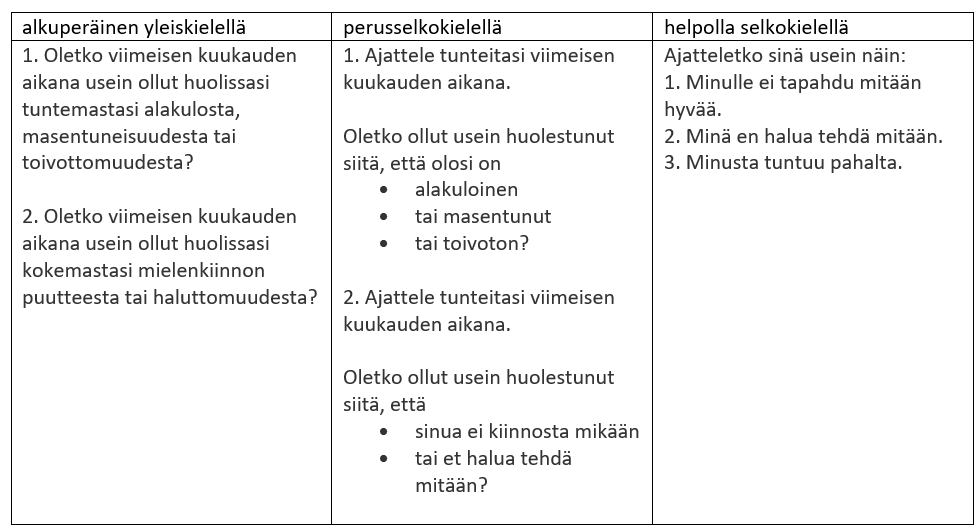 Kuva 2. Vasemmassa sarakkeessa yleiskielinen masennuksen seulonnassa käytettävä lomake, keskellä sen pohjalta tehty perusselkokielinen mukautus ja oikeassa laidassa mukautus helpolle selkokielelle.
Kuva 2. Vasemmassa sarakkeessa yleiskielinen masennuksen seulonnassa käytettävä lomake, keskellä sen pohjalta tehty perusselkokielinen mukautus ja oikeassa laidassa mukautus helpolle selkokielelle.
Tutkimuksen toisessa vaiheessa nämä kolme vaikeustasoltaan erilaista versiota käännätettiin arabiaksi, farsiksi, englanniksi, ruotsiksi ja venäjäksi. Käännösprosessin jälkeen meillä oli siis kahdeksantoista versiota alkuperäisestä lomakkeesta.
Tutkimuksen kolmannessa vaiheessa pyysimme terveydenhoidossa työskenteleviä tulkkeja arvioimaan, miten hyvin lomakkeen eri versiot toimisivat tulkkaustilanteessa. Tähän vaiheeseen osallistui yhteensä kymmenen tulkkia, kaksi kutakin kieltä kohti.
Pilottitutkimuksemme päätulos oli se, että selkokielisistä lomakkeista voi olla paljon hyötyä tulkkaustilanteessa. Tulkit kokivat, että he pystyvät kyllä tulkkaamaan alkuperäisen yleiskielisen lomakkeen, mutta jos tarjolla olisi selkokielisiä versioita, niistä olisi tulkkaustilanteessa apua. Tulkkeja pyydettiin myös arvioimaan eri versioiden sopivuutta asiakkaille, joilla oli tulkkaustarpeen lisäksi jokin muu kieleen tai ymmärtämiseen vaikuttava ominaisuus. Kuten kuvassa 3 näkyy, tulkit valitsivat erilaisille asiakkaille vaikeustasoltaan erilaisia versioita.
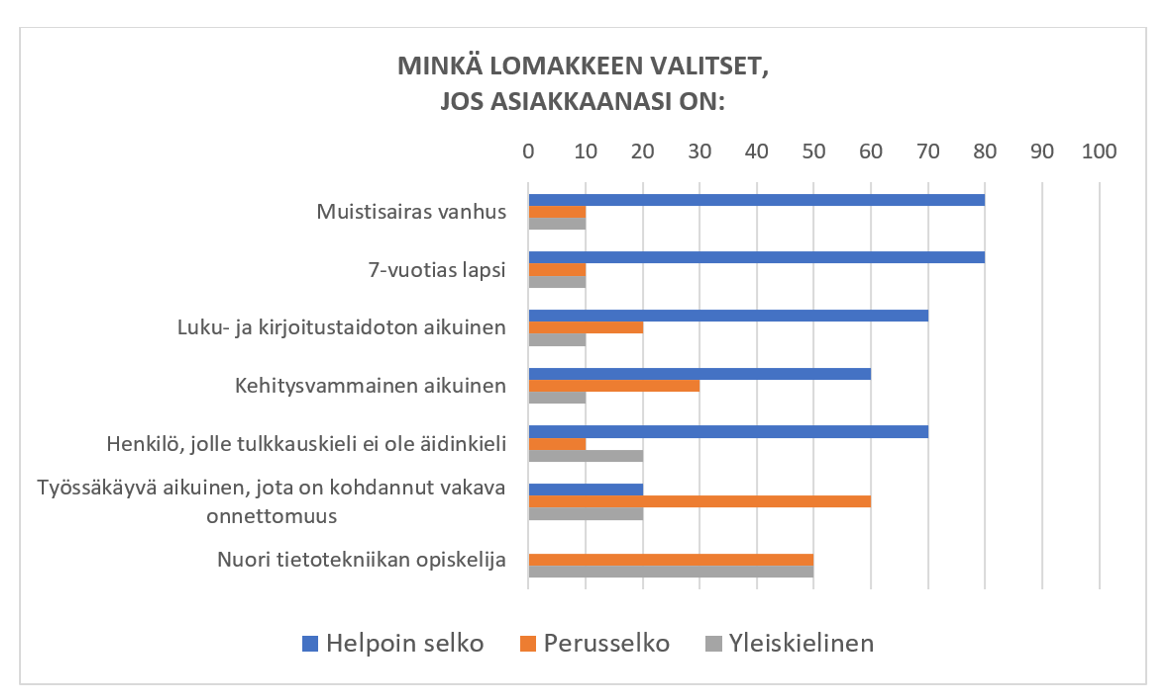
Kuva 3. Terveydenhoidossa työskentelevät tulkit valitsivat masennuksen seulonnassa käytettävästä lomakkeesta vaikeustasoltaan erilaisia versioita erilaisille asiakkaille. 80% vastaajista valitsi muistisairaalle vanhukselle tai 7-vuotiaalle lapselle helpoimman mahdollisen selkoversion. Nuorelle tietotekniikan opiskelijalle 50% vastaajista valitsi yleiskielisen version ja 50% perusselkokielisen version.
Tulkkeja pyydettiin myös arvioimaan sitä, mikä kaikista eri lomakevaihtoehdoista olisi tulkkauksen onnistumisen kannalta paras. Kiinnostavaa oli, että selkokielinen lomake suomeksi koettiin paremmaksi kuin yleiskielinen lomake kohdekielellä.
Pilottitutkimuksemme aineisto oli pieni, ja asiaa tulisikin tutkia lisää. Tutkimusasetelmaa kannattaisi laajentaa tulkeista terveydenhuollon asiakkaisiin ja ammattilaisiin. Kiinnostava, mutta kielentutkijan asiantuntemuksen ulkopuolelle kasvava kysymys on selkomukautettujen lomakkeiden validointi.
Alustavat tulokset herättävät pohtimaan terveydenhoidossa käytettävien lomakkeiden kääntämistä ja selkokielistämistä laajemminkin. Voisiko esimerkiksi Käypähoito-sivustolta joskus löytyä yleiskielisen lomakkeen lisäksi lomakkeiden selkoversioita – ja jopa kahdella vaikeustasolla?
Mielenterveyden asiantuntijat peräänkuuluttavat maahanmuuttajataustaisten henkilöiden psykologiseen arviointiin luovia ja soveltavia ratkaisuja silloin, kun pääväestölle suunnatut tutkimus- ja arviointimenetelmät eivät toimi. Eritasoiset selkomukautukset voisivat olla tällaisia ratkaisuja. Ihannetilanteessa mielenterveyden ongelmien tunnistamisessa ja diagnosoinnissa käytettävän lomakkeen kielen taso tulisi voida valita lääkärin vastaanotolla. Asiakkaan tulisi voida itse valita hänelle ymmärrettävä lomake. Selkomukautetun lomakkeen saattaisi valita myös moni sellainen, jonka ei katsota kuuluvan selkokielen kohderyhmiin.
Blogiteksti perustuu Ulla Vanhatalon ja Camilla Lindholmin artikkeliin Simplifying phrases in depression screens: Interpreters’ views on usefulness in six languages – julkaisutieto päivitetty 11.12.2023
Lähteitä
Castaneda, Anu E.; Mäki-Opas, Johanna; Jokela, Satu; Kivi, Nina; Lähteenmäki, Minna; Miettinen, Tanja; Nieminen, Satu; Santalahti, Päivi 2018. Pakolaisten mielenterveyden tukeminen Suomessa: PALOMA-käsikirja
Goddard, Cliff (ed.) 2018. Minimal English For a Global World: Improved Communication Using Fewer Words. Palgrave Macmillan
Vanhatalo, Ulla & Camilla Lindholm 2021. Rephrasing PRIME-MD PHQ 2 Question Depression Screen in Easy and Translatable Language. Conference presentation. KLAARA 2021. 2nd Conference on Easy-to-Read Language Research.
Whooley, M. A., Avins, A. L., Miranda, J., & Browner, W. S. (1997). Case-finding instruments for depression. Two questions are as good as many. Journal of general internal medicine, 12(7), 439–445. https://doi.org/10.1046/j.1525-1497.1997.00076.x
Wierzbicka, Anna 2014. “Pain” and “suffering” in cross-linguistic perspective. – International Journal of Language and Culture, Volume 1, Issue 2, Jan 2014, p. 149 – 173. DOI: https://doi.org/10.1075/ijolc.1.2.02wie

